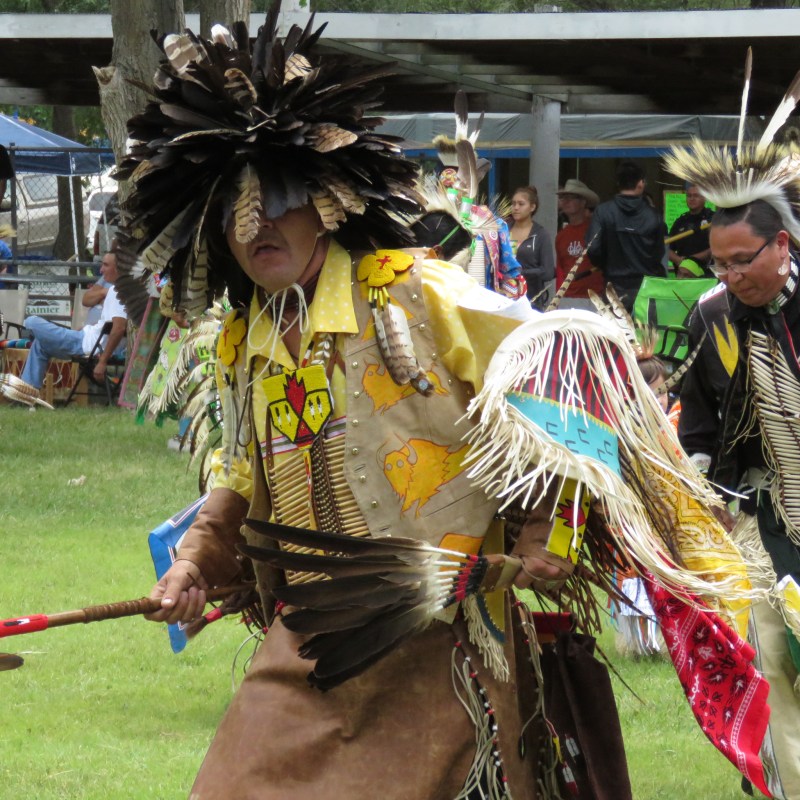
Tim Trudell
As a member of the Isanti Dakota (Santee Sioux), I grew up attending powwows. The Sioux Nation calls them wacipi (pronounced wa-CHEE-pee). As a child, I remember them being a fun time, where people were colorfully dressed and danced as the drums beat out the rhythm.
Videos by TravelAwaits
It took me until adulthood, however, to truly understand what powwows mean to our people. Powwows are a celebration of community and spirituality that honor a tribe’s past and present. At these events, Native Americans from around the region and beyond gather to dance, sing, and enjoy camaraderie.
Perhaps you’ve thought about attending a powwow on a Native American reservation — or perhaps an intertribal celebration at a university or community park — but weren’t sure if you could. Tribes encourage non-Native Americans to visit their reservations and attend their powwows, since food and dance are considered part of the international language of community. You can find powwows in your area on the PowWows website or on individual tribes’ Facebook pages.
Once you’ve decided to attend, what should you do to prepare? Basically, be respectful and come prepared to enjoy the pageantry and music, as well as the delicious food options.
There is a code of etiquette to powwows; it covers everything from when to stand to when photography is allowed. I recommend familiarizing yourself with these rules so that you can maximize your experience and enjoy your visit.

Tim Trudell
1. Be Respectful
Respecting tribal customs and traditions ranks as the most important rule of etiquette to remember. Don’t make comments or wear clothing that could be considered offensive.
While this might seem obvious, you might be surprised at how often people break these rules. If you’re not sure you should wear it or say it, then it’s probably best not to. For example, avoid discussions about politics or political candidates. Don’t wear clothing with athletic logos that stereotype indigenous people. Ethnic jokes shouldn’t even be considered. These rules are common sense, but again, you might be surprised how often these things occur.
Remember, you’re a guest on another sovereign nation’s soil. Tribes are considered their own nation in the eyes of the world and by treaty with the United States federal government (it’s a complicated relationship with a complicated history). Treat people as you would like to be treated.
However, if you have questions, don’t hesitate to ask. Just be respectful. It’s normal to want to know more about the tribe’s history, specific dances, and the role of the drum. People will be happy to share with you. After all, that’s one of the purposes of a powwow.
2. Don’t Break The Circle
Every powwow centers on the Circle. The Circle is sacred and plays a major role in Native American tradition. It symbolizes a neverending world where time is fluid and everyone is treated equally.
As Black Elk, a well-known Lakota Sioux medicine man, said, everything revolves around the Circle. The sun is round and completes its rotation in a circle, as does the moon. The Circle has four paths, each featuring a wind and identified by color.
The red path represents the North. Harsh during its season, the north wind is seen as cleansing, challenging those traveling in its direction. The red path is known for difficulties, and those who travel upon it are credited with patience.
The black path represents the West. It signifies the end of a person’s life, because this is where the sun sets. Since thunderstorms and rain come from this direction, the black path is known as the source of water, which the world needs for survival.
The yellow path represents the East, where the sun rises, bringing knowledge and understanding.
The white path represents the South, the place where life begins.
The Circle should never be broken. When you’re at a powwow, do not walk through a drum group’s setting, across the dance grounds, or anywhere else. Always walk around the Circle of the powwow. Your respect will be appreciated.

Tim Trudell
3. Stand During The Opening Ceremonies
Most powwows have two sessions, one in the afternoon and one in the evening. Each session features a grand entry.
A grand entry is a beautiful sight to behold. Hundreds of dancers line up based on their dance styles. Led by members of local veterans groups, they enter as drum groups play welcoming songs. The veterans mix dance with military marches, carrying the eagle staff, the American flag, the state flag, and tribal flags. They’re followed by the dancers, each group entering in its own dance style. As the dancers fill the dance ground, they move as part of the larger Circle.
Once everyone has entered and the last drum group has finished its song, the opening ceremonies take place, including a welcome address, prayers, and the placement of the flags and eagle staff. Guests are expected to stand during this time as a sign of respect.
4. When The Drum Group Plays, Stand When Your Neighbors Stand
The drums are often referred to as the heartbeat of a powwow, and the drum groups quite possibly play the most important role in the festivities. Key to a powwow’s success, they control the flow of the dances and the gathering.
Everything about a drum group is special, down to the process of drummaking. A drum is made by stretching animal hides over a wooden circular frame — it’s a tradition that’s been passed down through generations. Drummers spend long hours looking for the perfect drumstick, and they’ll often be gifted one as a thank-you from a tribal member or supporter.
It’s a great honor to be invited to serve on a drum group. Drum groups learn traditional songs, each key to a particular kind of dance. Drum groups are called upon throughout a powwow to perform a number of pieces, from military songs for each branch of service to prayers to traditional dances.
You’ll need to stand during certain songs. The master of ceremonies will likely advise you when to do so. If not, just keep an eye on your neighbors; when they stand, you stand.
Also, do not take a seat in the first row behind the drummers. Those seats are usually reserved for the dancers. Besides, sitting a few rows back allows you to see more of the event.
Never step through a drum group — it forms its own circle.

Tim Trudell
5. Show Appreciation For Members Of The Military
Military service means a lot to Native Americans. You’d think otherwise based on the historical relationship between indigenous people and the federal government. However, Native Americans have the highest rate of military service per capita among all ethnic groups. Before the 1924 Indian Citizenship Act granted Native Americans citizenship, the U.S. offered citizenship to Native Americans who served in World War I.
The grand entry at most powwows is led by military veterans carrying the tribe’s war staff, the American flag, and tribal flags. The symbols are showcased in the center of the dance grounds. American flags often ring the dance circle, hanging from poles. Some tribes use flags donated by the families of deceased tribal veterans. Tribes may have drum groups perform songs for each service branch.
If you happen to meet one of these veterans, don’t hesitate to offer a word of gratitude for their service.
6. Don’t Touch The Dancers’ Regalia
The dances at a powwow vary in style and meaning.
While there are regional differences, traditional dances generally involve slower movements and steps. Traditional dances include the Grass and the Buffalo Hunt. Each is impressive to watch, as the dancers seem to flow together in perfect harmony.
Fancy dances involve colorful regalia and quick steps, with the dancers’ feet barely touching the ground. These dances are popular with younger dancers, and the quick movements distinguish them from traditional ones. One of my favorite fancy dances is the Jingle, where the jingling of the regalia merges with the drum’s beating and the singers’ voices to produce a dramatic effect. Another fancy dance is the Shawl, where women of all ages dance while displaying their colorful shawls. On the men’s side, young fancy dancers in brightly colored attire and accessories quickly rotate around the dance grounds.
A dancer’s attire is not referred to as an outfit or costume. It is called regalia. Each dancer’s regalia is special, with a spiritual or family connection. A lot of planning and work goes into creating it. Respect the dancers, and don’t touch their regalia or ask to touch it.
7. Ask Permission Before Taking Photos
Photos are acceptable during dances, except for during special moments or prayer time. The master of ceremonies will normally advise guests when not to take photos. However, common sense should prevail as well.
When you meet a dancer away from the Circle, ask their permission before taking a photo. Sometimes, they may decline. This may be because they don’t want others to see the intricacies of their regalia and try to copy the style.

Tim Trudell
8. Don’t Be Afraid To Try The Food Options
At any powwow, the dancing is the main event, but the food is also a highlight. You’ll find all kinds of goodies available, from traditional Native tacos to barbecue and hot dogs.
Don’t leave without trying a Native taco (also known as an Indian or NDN taco). It consists of handmade fry bread, and taco ingredients are added on top (usually seasoned ground beef, lettuce, onions, tomatoes, and hot sauce). Some vendors will include jalapenos. I grew up eating fry bread at my grandmother’s, and it’s one of the things I most look forward to when attending a powwow.
Other foods you’ll find at powwows include gigantic turkey legs, fried corn cobs, barbecued beef, and chili. They’re delicious, no matter the temperature outside.
9. Don’t Try To Barter
At a powwow, you’ll likely see vendors selling their wares. Powwows are a great place to purchase authentic Native American art and crafts. These items range in price, but unlike at other markets, you shouldn’t barter, since it’s considered disrespectful. The vendors spend a lot of time and effort crafting their art, clothing, and jewelry.
I collect ball caps and try to buy one featuring traditional designs at every powwow. Browse all of the offerings for the best deals.
As the powwow season gets underway, tribes across North America will be hosting events, and there will almost certainly be one in your state or nearby.
Attending a powwow is a great way to bridge the culture gap and learn more about an important part of our nation’s heritage. The more we know about others, the smaller the world becomes, and we realize we have more in common than we thought.
As you plan your visit, just remember that the basic rule of powwow etiquette is respect. Show respect, and the tribes will welcome you with open arms.
